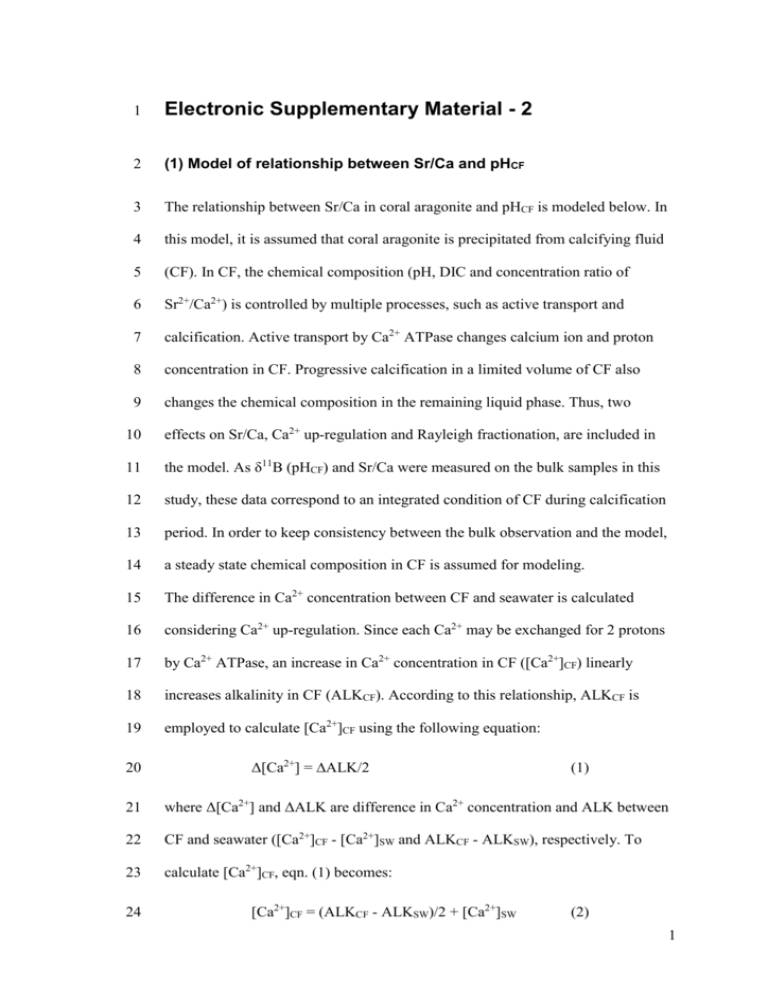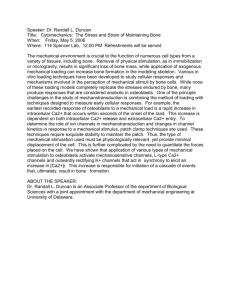Author template for journal articles
advertisement

1
Electronic Supplementary Material - 2
2
(1) Model of relationship between Sr/Ca and pHCF
3
The relationship between Sr/Ca in coral aragonite and pHCF is modeled below. In
4
this model, it is assumed that coral aragonite is precipitated from calcifying fluid
5
(CF). In CF, the chemical composition (pH, DIC and concentration ratio of
6
Sr2+/Ca2+) is controlled by multiple processes, such as active transport and
7
calcification. Active transport by Ca2+ ATPase changes calcium ion and proton
8
concentration in CF. Progressive calcification in a limited volume of CF also
9
changes the chemical composition in the remaining liquid phase. Thus, two
10
effects on Sr/Ca, Ca2+ up-regulation and Rayleigh fractionation, are included in
11
the model. As δ11B (pHCF) and Sr/Ca were measured on the bulk samples in this
12
study, these data correspond to an integrated condition of CF during calcification
13
period. In order to keep consistency between the bulk observation and the model,
14
a steady state chemical composition in CF is assumed for modeling.
15
The difference in Ca2+ concentration between CF and seawater is calculated
16
considering Ca2+ up-regulation. Since each Ca2+ may be exchanged for 2 protons
17
by Ca2+ ATPase, an increase in Ca2+ concentration in CF ([Ca2+]CF) linearly
18
increases alkalinity in CF (ALKCF). According to this relationship, ALKCF is
19
employed to calculate [Ca2+]CF using the following equation:
20
Δ[Ca2+] = ∆ALK/2
(1)
21
where Δ[Ca2+] and ΔALK are difference in Ca2+ concentration and ALK between
22
CF and seawater ([Ca2+]CF - [Ca2+]SW and ALKCF - ALKSW), respectively. To
23
calculate [Ca2+]CF, eqn. (1) becomes:
24
[Ca2+]CF = (ALKCF - ALKSW)/2 + [Ca2+]SW
(2)
1
25
Because [Ca2+]SW is proportional to salinity, [Ca2+]SW is calculated to be constant
26
at 10.0 mmol mol-1 at salinity of 34.2. ALKSW measured during culturing was
27
almost constant among three treatments (2324 µmol kg-1). As ALK can be
28
calculated from pH and DIC (Zeebe and Wolf-Gladrow, 2001) (Fig. S1), ALKCF
29
is calculated from pHCF and DICCF in the model. Because an increase in pH (at a
30
given DIC) and/or DIC (at a given pH) raises ALK in the solution, ΔALK can be
31
divided into two, that is, ΔALK due to pH change (ΔALKpH) and due to DIC
32
change (ΔALKDIC) (ΔALK = ΔALKpH + ΔALKDIC). pHCF is higher than ambient
33
seawater (Fig. 3). Possible diffusion of metabolic CO2 from the tissue to CF raises
34
DIC in CF (DICCF) to values higher than that in seawater (DICSW). Thus, in the
35
model, pH and DIC in CF potentially influence ALKCF and [Ca2+]CF.
36
For the calculation of ALKCF, pHCF ranges from 8.0 to 8.8 with calculations made
37
for every 0.1 pH change (on total scale). In order to distinguish effects of pH and
38
DIC on [Ca2+]CF and Sr/Ca in aragonite, DICCF is fixed at seawater value of 1959,
39
2121 and 2284 µmol kg-1 observed in CNT, MID and LOW treatments,
40
respectively (DICCF = DICSW). The calculation of ALKCF is conducted using
41
software of CO2-sys (Lewis and Wallace, 1998). In this point, ALKCF is
42
calculated by varying pHCF at identical DICCF with DICSW to obtain ΔALKpH.
43
[Ca2+]CF considering only pH effect ([Ca2+]CF-pH) is calculated from ΔALKpH
44
based on eqn. (2).
45
[Ca2+]CF-pH = (ALKCF-pH - ALKSW)/2 + [Ca2+]SW
(3)
46
Active transport of strontium is assumed to be negligible. Then Sr2+/Ca2+ in CF
47
([Sr2+/Ca2+]CF-pH), affected by only pHCF, is calculated as:
48
[Sr2+/Ca2+]CF-pH = [Sr2+]SW / [Ca2+]CF-pH
(4)
2
49
where [Sr2+]SW is proportional to salinity of seawater, being 0.0862 mmol mol-1 at
50
salinity of 34.2.
51
Progressive calcification gradually decreases the Sr2+/Ca2+ ratio in CF, assuming
52
that CF is nearly a closed system, because the distribution coefficient of Sr/Ca
53
between aragonite and parent solution is larger than unity. Rayleigh fractionation
54
is applied to consider this effect in the model. Sr/Ca in coral aragonite ([Sr/Ca]CO-
55
ARA)
56
effect is calculated as below:
57
influenced by Ca2+ up-regulation associated with pHCF, and the Rayleigh
[Sr/Ca]CO-ARA = DSr/Ca [Sr2+/Ca2+]CF-pH F’
(5)
58
where DSr/Ca is the distribution coefficient of Sr/Ca between parent solution and
59
aragonite (DSr/Ca = 1.15 at SST of 29.3 ˚C) (Gaetani and Cohen 2006). F’
60
represents the degree of progress of calcification relative to the reservoir
61
replenishment, for which values are unconstrained. We run the model using four
62
fixed value of F’ (1.00, 0.98, 0.97 and 0.95) where a value of 1 would represent
63
rapid renewal relative to calcification thus no Rayleigh effect, while smaller
64
values of F’ indicate lower rates of renewal relative to precipitation and thus
65
greater Rayleigh effects.
66
In addition, Sr/Ca in aragonite ([Sr/Ca]SW-ARA) inorganically precipitated from
67
seawater, is also calculated as:
68
69
[Sr/Ca]SW-ARA = DSr/Ca[Sr2+/Ca2+]SW
(6)
where [Sr2+/Ca2+]SW represents Sr2+/Ca2+ ionic ratio in the seawater.
70
3
71
(2) Estimate of DIC and Ω in CF
72
Fig. S2 is schematic relationship among [Sr/Ca]SW-ARA, [Sr/Ca]CO-ARA, and the
73
measured Sr/Ca ([Sr/Ca]MEAS). As described above, [Sr/Ca]CO-ARA includes effects
74
by Ca2+ up-regulation (Δ[Ca2+]pH) and Rayleigh effect (F’). In contrast, [Sr/Ca]SW-
75
ARA
76
difference between [Sr/Ca]SW-ARA and [Sr/Ca]CO-ARA at F’ = 1.0 represents effect
77
by Ca2+ up-regulation due to pH effect (Fig. S2). In addition, the difference
78
among [Sr/Ca]CO-ARA of various F’ values represent Rayleigh effect on Sr/Ca (Fig.
79
S2).
80
Although DICCF is assumed to be the same as DICSW, it is likely that DICCF is also
81
up – regulated by diffusion of CO2 into CF, influencing [Sr/Ca]MEAS. Thus,
82
assuming that pH and DIC in CF are higher than ambient seawater, [Sr/Ca]MEAS is
83
represented as:
84
is calculated without these effects (i.e. Δ[Ca2+]pH = 0 and F’ = 1.0). Thus, the
[Sr/Ca]MEAS = (DSr/Ca ([Sr2+]SW/([Ca2+]SW + Δ[Ca2+]pH + Δ[Ca2+]DIC))) F’ (7)
85
where Δ[Ca2+]DIC links to ΔALKDIC as: Δ[Ca2+]DIC = ΔALKDIC/2, according to
86
eqn. (1) (see Fig. S1). Therefore, the difference between [Sr/Ca]CO-ARA (F’ = 1.0)
87
and [Sr/Ca]MEAS represents the effect of DIC up – regulation (Δ[Ca2+]DIC) and
88
Rayleigh effect (F’) (Fig. S2). Further, when F’ of [Sr/Ca]MEAS is identical with
89
that of [Sr/Ca]CO-ARA, the difference simply corresponds to DIC up – regulation.
90
Combining eqn. (4), (5) and (7), the next equation is obtained to calculate
91
Δ[Ca2+]DIC.
92
Δ[Ca2+]DIC = DSr/Ca[Sr2+]SWF’{([Sr/Ca]MEAS)-1 – ([Sr/Ca]CO-ARA)-1}
(8)
93
It is possible to calculate Δ[Ca2+] as a sum of Δ[Ca2+]pH (eqn. (3)), and Δ[Ca2+]DIC
94
(eqn. (8)) at a given F’ value. As described in the text, four values of F’ (1.00,
95
0.98, 0.97 and 0.95) are used for estimates. Then, ΔALK for each sample is
4
96
calculated from eqn. (1), and ALKCF including effects of pH and DIC is obtained
97
as: ALKCF = ALKSW + ΔALK. Finally, DICCF and carbonate ion concentration in
98
CF ([CO32-]CF) are calculated from ALKCF from the above equation and pHCF
99
derived from δ11B, based on Zeebe and Wolf-Gladrow (2001).
100
Using Ca2+ and CO32- ion concentrations in CF, aragonite saturation state in CF
101
(ΩCF) is calculated as below:
102
ΩCF = [Ca2+]CF [CO32-]CF /KSP
(9)
103
where KSP is the solubility product of aragonite in seawater (Mucci 1983) at
104
temperature of 29.3 ˚C and salinity of 34.2 (KSP = 10-6.21).
105
106
107
108
109
110
111
112
113
114
115
References
Gaetani G, Cohen A (2006) Element partitioning during precipitation of aragonite from seawater:
A framework for understanding paleoproxies. Geochim Cosmochim Acta 70:4617-4634
Lewis E, Wallace D (1998) Program developed for CO 2 System Calculations. URL:
http://cdiac.esd.ornl.gov/oceans/co2rprtnbk.html
Mucci A (1983) The solubility of calcite and aragonite in seawater at various salinities,
temperatures, and one atmospheric total pressure. Am J Sci 283:780-799
Zeebe RE and Wolf-Gladrow DA (2001) CO2 in Seawater: Equilibrium, Kinetics, Isotopes.
Elsevier, Amsterdam.
5
116
Figure captions
117
Figure S1
118
Relationship between pH and ALK calculated using DIC values of 1960 and 2280
119
µmol kg-1 (black and dark blue line, respectively). Difference in ALK (diff-ALK)
120
between black diamond (pH 8.4, DIC 1960 µmol kg-1) and dark blue diamond (pH
121
8.6, DIC 2280 µmol kg-1) is divided into pH effect (ΔALKpH, light blue arrow)
122
and DIC effect (ΔDICpH, amber arrow).
123
124
Figure S2
125
Schematic of relationship among [Sr/Ca]SW-ARA (light blue), [Sr/Ca]CO-ARA (dark
126
blue) and [Sr/Ca]MEAS (amber circle). Light blue, dark blue and amber arrows
127
indicate reduction of Sr/Ca due to pH effect, Rayleigh effect, and DIC effect,
128
respectively.
6



![Substantiation of the Rhod-2 as indicator of cytosolic [Ca2+] Rhod](http://s3.studylib.net/store/data/006893824_1-225923ad9f8cdb438dcdcf307ccbe9bd-300x300.png)




